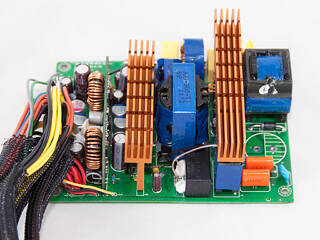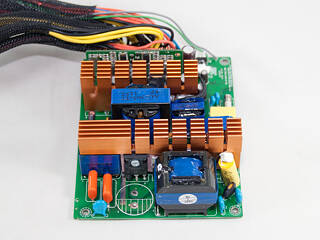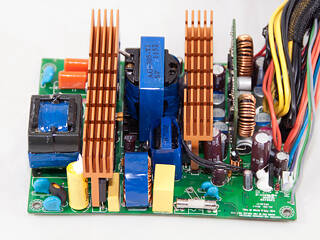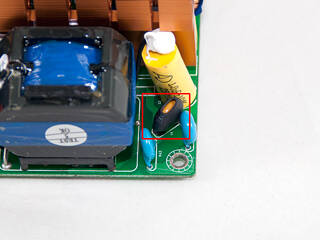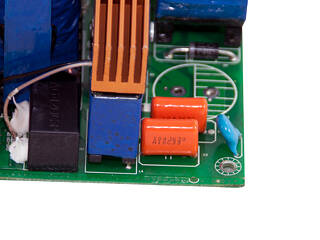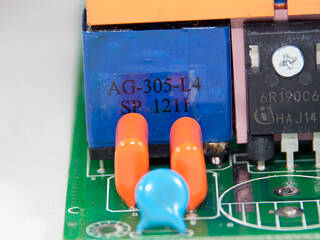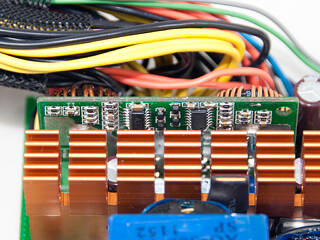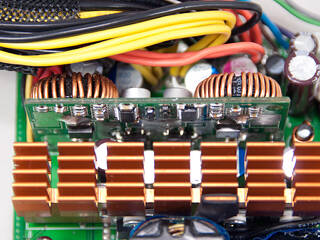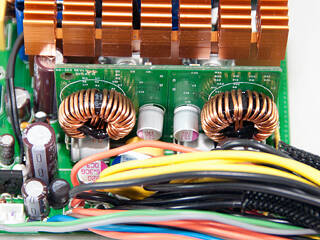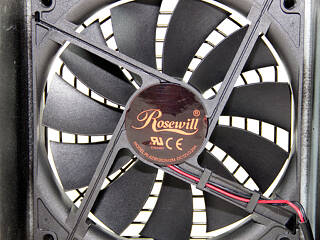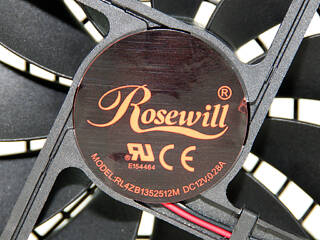 0
0
Rosewill Fortress 550 W Review
Voltage Regulation & Efficiency »A Look Inside
Before reading this page, we strongly suggest you take a look at this article, which will help you understand much better the internal components of a PSU.The OEM of all Fortress units is ATNG, a manufacturer that we seldom hear about but still has some rather interesting platforms to exhibit. When we remove the top part of the case, we can see a really small PCB which could easily be housed in a much smaller casing. Nevertheless, Rosewill most likely wanted to use the same thing for all Fortress units. This PSU uses a modern platform to achieve Platinum-level efficiency, since on the primary side we can see an LLC resonant converter, while on the secondary side, two DC-DC converters generate the minor rails and the +12V rails are rectified by mosfets (active or synchronous rectification).
Behind the AC receptacle is a small PCB housing many transient filtering components such as two pairs of X and Y caps, as well as a CM choke.
The transient filter continues on to the main PCB with two additional pairs of X and Y caps, a CM choke, and an MOV which, strangely enough, is located after the bridge rectifier and the PFC input cap.
The single-bridge rectifier is bolted onto the main heatsink.
In the APFC, a single FET, most likely a IPW60R190CP, separates the intermediate DC voltage coming from the bridge rectifier into constant pulse sequences and a boost diode (CREE C3D06060) boosts the pulsating rectified mains up to a loosely regulated ~380 V DC bus voltage. The single hold-up cap is provided by Nichicon (400 V, 330 µF, 105°C). As main switches, two IPW60R190CP transistors are used.
The PFC controller is installed on this small vertical daughterboard and its model number is CM6502S.
The two orange caps along with the inductor hidden under the main heatsink are the main parts of the LLC resonant converter.
The standby PWM controller is an STR-A6059H IC.
On the secondary side, the +12V rail handles four IPP041N04N FETs. Moreover, two DC-DC converters generate the minor rails from +12V. At each VRM, we find a dedicated PWM controller and two FETs.
On the secondary side, mostly polymer caps are used, all provided by Capxon except one made by Teapo; we can also see some Nippon Chemi-Con electrolytic caps rated at 105°C (KY series).
Soldering quality on the main PCB is not that good, especially on the secondary side where there are many ugly and blobby solder joints. These solder joints may have no effect on the performance of the unit, but, definitely, they are unsightly for a reviewer. On this side, the LLC resonant controller is also soldered, a CM6901 IC.
The cooling fan carries Rosewill's logo, but its model number, RL4Z-B1352512M (12 V, 0.28 A), reveals its real OEM which is Globefan. It uses double ball bearings, so it will last quite long and is very quiet at all times, as we have discovered during our test sessions.
Apr 26th, 2024 11:03 EDT
change timezone
Latest GPU Drivers
New Forum Posts
- Cs2 Freezing in Rx 580 (5)
- im new to throttelstop and i think i messed it up by copying others any hints would be very much aprreciated (4)
- Ghost of Tsushima PC Port !!!! (15)
- The Official Linux/Unix Desktop Screenshots Megathread (699)
- Red Dead Redemption using emu (4)
- Meta Horizon OS (21)
- Old high quality PSU, or semi-old mid-quality PSU? (3)
- Secure boot already open help (8)
- What are you playing? (20540)
- Horizontal black lines popping up on my screen? (13)
Popular Reviews
- HYTE THICC Q60 240 mm AIO Review
- MOONDROP x Crinacle DUSK In-Ear Monitors Review - The Last 5%
- Alienware Pro Wireless Gaming Keyboard Review
- Upcoming Hardware Launches 2023 (Updated Feb 2024)
- ASUS GeForce RTX 4090 STRIX OC Review
- Thermalright Phantom Spirit 120 EVO Review
- ASUS Radeon RX 7900 GRE TUF OC Review
- FiiO K19 Desktop DAC/Headphone Amplifier Review
- RTX 4090 & 53 Games: Ryzen 7 5800X vs Ryzen 7 5800X3D Review
- NVIDIA RTX 4090: 450 W vs 600 W 12VHPWR - Is there any notable performance difference?
Controversial News Posts
- Windows 11 Now Officially Adware as Microsoft Embeds Ads in the Start Menu (125)
- Sony PlayStation 5 Pro Specifications Confirmed, Console Arrives Before Holidays (117)
- NVIDIA Points Intel Raptor Lake CPU Users to Get Help from Intel Amid System Instability Issues (106)
- AMD "Strix Halo" Zen 5 Mobile Processor Pictured: Chiplet-based, Uses 256-bit LPDDR5X (101)
- US Government Wants Nuclear Plants to Offload AI Data Center Expansion (98)
- AMD's RDNA 4 GPUs Could Stick with 18 Gbps GDDR6 Memory (92)
- Developers of Outpost Infinity Siege Recommend Underclocking i9-13900K and i9-14900K for Stability on Machines with RTX 4090 (85)
- Windows 10 Security Updates to Cost $61 After 2025, $427 by 2028 (84)
